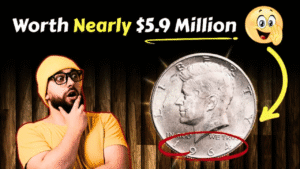Ever wonder if the $5 bill in your wallet could be worth more than a quick lunch? Believe it or not, some $5 bills—specifically rare star notes—can fetch up to $60,000 at auction! These special bills, marked with a tiny star in the serial number, are collector’s treasures. Ready to check your cash? Let’s dive into what makes a $5 star note so valuable, how to spot one, and why it could turn your pocket change into a small fortune.
What Is a Star Note?
A star note is a unique type of U.S. currency issued by the U.S. Bureau of Engraving and Printing to replace bills damaged or misprinted during production. Instead of a regular serial number, these replacements have a star symbol (*) at the end, making them stand out. Star notes are printed in much smaller quantities than standard bills, which makes them rare and highly sought after by collectors.
Why Are $5 Star Notes So Valuable?
The value of a star note comes from its scarcity and unique features. While millions of regular $5 bills are printed, star note runs can be as small as a few hundred thousand, especially for certain series like 1934 or 2003. Collectors also prize star notes with special serial numbers—like low digits or repeating patterns—or those in pristine, uncirculated condition. Some, like a 1934 $5 star note, have sold for nearly $60,000 due to their rarity and perfect preservation.
Top Features That Make a $5 Star Note Valuable
Not every star note is a jackpot, but certain traits can skyrocket its worth. Here’s what to look for:
1. Star Symbol in the Serial Number
- The hallmark of a star note is a star (*) at the end of the serial number, found in the top-right or bottom-left corner of the bill.
- Example: A serial number like “B12345678*” indicates a star note.
2. Series Year
- Check the year printed near Abraham Lincoln’s portrait. Older series like 1934 or modern ones like 2003 are often more valuable due to limited star note print runs.
- A 1934 $5 star note in uncirculated condition sold for $60,000, while a 2003 star note with a low serial number fetched $20,000.
3. Unique Serial Numbers
- Collectors love patterns like:
- Low Numbers: e.g., “00000005*” (worth thousands).
- Repeating Digits: e.g., “77777777*” (can fetch $10,000+).
- Ladder Numbers: e.g., “12345678*” (valued at hundreds to thousands).
- Use a magnifying glass to check the serial number closely.
4. Condition
- Bills in uncirculated condition—no folds, tears, or stains—are worth far more. A crisp, clean star note can be 10 times more valuable than a worn one.
- Handle with care to preserve its condition.
How Much Are $5 Star Notes Worth?
The value of a $5 star note depends on its rarity, series, serial number, and condition. Here’s a quick breakdown:
| Series Year | Condition | Approximate Value | Why It’s Valuable |
|---|---|---|---|
| 1934 Star Note | Uncirculated | Up to $60,000 | Low print run, pristine condition |
| 2003 Star Note | Uncirculated, Low Serial | Up to $20,000 | Rare serial number, high grade |
| Common Star Note | Circulated | $10–$20 | Slight premium for star symbol |
| Star Note with Unique Serial | Uncirculated | $500–$10,000+ | Repeating or ladder numbers |
How to Check If Your $5 Bill Is a Rare Star Note
Spotting a valuable $5 star note is quick and easy. Follow these steps:
- Locate the Serial Number: Check the top-right or bottom-left corner for a star (*) at the end of the serial number.
- Note the Series Year: Look near Lincoln’s portrait for the year. Key years like 1934 or 2003 are worth checking.
- Inspect the Serial Number: Look for low numbers (e.g., “00000005*”), repeating digits (e.g., “77777777*”), or ladders (e.g., “12345678*”).
- Check Condition: Ensure the bill is crisp, with no creases or damage. Use gloves or tweezers to avoid fingerprints.
- Research Rarity: Visit sites like MyCurrencyCollection.com or uscurrencyauctions.com to see how many star notes were printed for that series. Smaller print runs mean higher value.
- Get It Appraised: Take it to a reputable coin shop or grading service like PCGS or PMG for professional evaluation.
Tips for Protecting Your Star Notes
Found a potential treasure? Keep it safe with these tips:
- Don’t Clean: Cleaning removes the natural patina, drastically lowering value.
- Store Properly: Use acid-free plastic sleeves or currency holders to prevent damage.
- Handle Carefully: Use gloves or tweezers to avoid oils from your skin.
- Get Professional Grading: Services like PCGS or PMG can authenticate and grade your bill, boosting its market value.
Real-Life Examples of High-Value $5 Star Notes
- 1934 $5 Star Note: An uncirculated example sold for $60,000 due to its rarity and perfect condition.
- 2003 $5 Star Note: A bill with a low serial number (e.g., “00000005*”) fetched $20,000 at auction.
- Unique Serial Number Star Note: A bill with a repeating pattern like “88888888*” sold for $12,000 in 2023.
How to Sell Your Rare $5 Star Note
Think you’ve got a valuable star note? Here’s how to cash in:
- Verify Features: Compare your bill’s year, serial number, and condition to known examples on sites like PCGS or Heritage Auctions.
- Get It Graded: Professional grading by PCGS or PMG confirms authenticity and increases value.
- Choose a Selling Platform: High-value notes sell best at auction houses like Heritage Auctions or Stack’s Bowers. For lower-value notes, try local coin shops or eBay.
Why Hunt for $5 Star Notes?
Searching for rare $5 star notes is like a treasure hunt in your everyday cash. These bills are still in circulation, especially from modern series like 2003, and finding one with a unique serial number or from a rare series like 1934 could mean a big payday. The thrill of discovering a valuable bill in your change makes it worth a quick look. So, next time you get a $5 bill, check for that star—it could be your ticket to thousands!
FAQs About $5 Star Notes
Q: What is a $5 star note?
A: A $5 star note is a replacement bill for damaged or misprinted currency, marked with a star (*) at the end of the serial number. They’re printed in smaller quantities, making them rare.
Q: How can I tell if my $5 bill is a star note?
A: Look for a star (*) at the end of the serial number in the top-right or bottom-left corner of the bill.
Q: Which $5 star notes are most valuable?
A: Star notes from 1934 (up to $60,000) or 2003 (up to $20,000) with low or unique serial numbers and uncirculated condition are the most valuable.
Q: Can I find $5 star notes in circulation?
A: Yes, star notes, especially from modern series like 2003, can still appear in pocket change or cash transactions.
Q: Where can I sell a rare $5 star note?
A: High-value star notes sell best at auction houses like Heritage Auctions or Stack’s Bowers. Common ones can be sold at coin shops or on eBay.
Q: Should I clean my $5 star note to make it look better?
A: No, cleaning damages the bill’s surface and lowers its value. Keep it untouched and consult a professional for grading.




